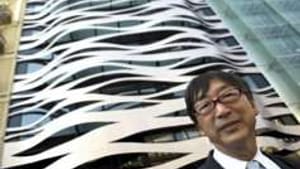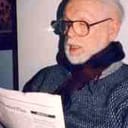Stay in the Loop
BSR publishes on a weekly schedule, with an email newsletter every Wednesday and Thursday morning. There’s no paywall, and subscribing is always free.
One man's quest for humane architecture
Toyo Ito: the humane architect

Omar Ahkbar, the Afghani who directed the Dessau Bauhaus creatively for several years, posed a question I'll not soon forget, at a recent Berlin Conference on Urban Design: "What have our starchitects done for the common man?"
Longish pause, before his solemn answer: "Nothing. Absolutely nothing."
Because he is a thoroughly decent man, I'm sure Akhbar would be as thrilled as I am by the Pritzker (Sur)Prize choice of 2013: Toyo Ito of Japan.
With tiny (but rapidly growing) exceptions like Cameron Sinclair's Architecture for Humanity, our architectural geniuses hunger to be the Frank Lloyd Wrights of their generation. Sinclair's "bible," Design As If You Give a Damn, urges his generation to use their talents in abolishing the scandal of the favela— the shantytown— in the fastest-growing Latin American economy.
Or employing the energies of unacknowledged prefab geniuses like Charles Goodman of National Homes (in Lafayette, Ind.) to bring American families out of utter urban darkness.
Or the 2 million Syrians scrabbling out of their hellhole to whatever tent town will take them.
Tsunami response
So cheer the good news of our newest Pritzker winner, who when his fellow Japanese were suffering from homelessness in the aftermath of a tsunami in Rikuzentakata, responded by forming "Home-for-All," a co-op that innovates to contain the pain and waste of the tragedies of their coevals.
It all started at the Venice Biennale of 2012, when Ito's collaborator Takamasa Yoshizaka designed "Architecture: Possible here? "'Home-for-all'," the dashes signifying the togetherness of their thinking. Toyo Ito curated the exhibition with the participation of architects Kumiko Inui, Sou Fujimoto and Akihisa Hirata— visualized by the photographer Naoya Hatakeyama. Group aid, to ensure the future.
The photographer illustrated Rikuzintakata, before and after the tsunami. Models illustrated solutions to the new crisis. When their exposition won the Biennale's Gold Lion in 2012, the jury noted, "The presentation and the storytelling in the Pavilion are exceptional and highly accessible to a broad audience. The jury was impressed with the humanity of this project." In other words, humane architecture involves more than a slide-rule.
Attacking isolation
It takes a visionary like Toyo Ito: "Immediately post-quake," he has written, "I proposed a project known as Home-for-All: an attempt to provide places where those who've lost their homes can enjoy a little breathing space— a place to meet, talk, eat and drink together. Those living in the temporary housing erected in the disaster zone may at least secure a minimum of privacy, but having lost their former communities, are compelled to live an isolated existence. Dwellings are small and thus unsociable. Even just to talk to the next-door neighbors requires standing outside on a bare gravel road.
"It struck me that we could supply small wooden buildings, places for people to gather, in a corner of these temporary housing sites, and I launched a campaign to do so. Soliciting funds from companies and organizations around the world, the idea is also to have manufacturers supply the materials free of charge."
(To learn more about Toyo Ito's superbly diverse achievements, click here.)
Ricky Wurman's idea
Toyo Ito is not only gifted physically in his work, but metaphysically as well: "Home-For-All" may indeed be a small project, but this process by which the buildings reach fruition is actually hugely significant, because it questions the very meaning of individual in the modern sense.
Since the onset of the modern period, architecture has been rated highest for its individual originality. As a result, the most primal themes— those of why a building is made, and for whom— have been forgotten.
But not by Louis Kahn's greatest protégé, Ricky Wurman, who in the 1970s created a curriculum on architecture for the Philadelphia public school system, currently lost in some long forgotten desk. Wurman went on to write a bookshelf of guides to our major cities. Then he devised TED (for "Technology, Entertainment and Design"), that media genius that used National Public Radio's empty Sundays to remind thoughtful Americans why we're foundering. I'm going to recommend to Danny Miller, long the silent genius of the Terry Gross "Fresh Air" operation, that he get Wurman and Toyo Ito together on TED. We need their wisdom, not to mention their pizzazz.
Longish pause, before his solemn answer: "Nothing. Absolutely nothing."
Because he is a thoroughly decent man, I'm sure Akhbar would be as thrilled as I am by the Pritzker (Sur)Prize choice of 2013: Toyo Ito of Japan.
With tiny (but rapidly growing) exceptions like Cameron Sinclair's Architecture for Humanity, our architectural geniuses hunger to be the Frank Lloyd Wrights of their generation. Sinclair's "bible," Design As If You Give a Damn, urges his generation to use their talents in abolishing the scandal of the favela— the shantytown— in the fastest-growing Latin American economy.
Or employing the energies of unacknowledged prefab geniuses like Charles Goodman of National Homes (in Lafayette, Ind.) to bring American families out of utter urban darkness.
Or the 2 million Syrians scrabbling out of their hellhole to whatever tent town will take them.
Tsunami response
So cheer the good news of our newest Pritzker winner, who when his fellow Japanese were suffering from homelessness in the aftermath of a tsunami in Rikuzentakata, responded by forming "Home-for-All," a co-op that innovates to contain the pain and waste of the tragedies of their coevals.
It all started at the Venice Biennale of 2012, when Ito's collaborator Takamasa Yoshizaka designed "Architecture: Possible here? "'Home-for-all'," the dashes signifying the togetherness of their thinking. Toyo Ito curated the exhibition with the participation of architects Kumiko Inui, Sou Fujimoto and Akihisa Hirata— visualized by the photographer Naoya Hatakeyama. Group aid, to ensure the future.
The photographer illustrated Rikuzintakata, before and after the tsunami. Models illustrated solutions to the new crisis. When their exposition won the Biennale's Gold Lion in 2012, the jury noted, "The presentation and the storytelling in the Pavilion are exceptional and highly accessible to a broad audience. The jury was impressed with the humanity of this project." In other words, humane architecture involves more than a slide-rule.
Attacking isolation
It takes a visionary like Toyo Ito: "Immediately post-quake," he has written, "I proposed a project known as Home-for-All: an attempt to provide places where those who've lost their homes can enjoy a little breathing space— a place to meet, talk, eat and drink together. Those living in the temporary housing erected in the disaster zone may at least secure a minimum of privacy, but having lost their former communities, are compelled to live an isolated existence. Dwellings are small and thus unsociable. Even just to talk to the next-door neighbors requires standing outside on a bare gravel road.
"It struck me that we could supply small wooden buildings, places for people to gather, in a corner of these temporary housing sites, and I launched a campaign to do so. Soliciting funds from companies and organizations around the world, the idea is also to have manufacturers supply the materials free of charge."
(To learn more about Toyo Ito's superbly diverse achievements, click here.)
Ricky Wurman's idea
Toyo Ito is not only gifted physically in his work, but metaphysically as well: "Home-For-All" may indeed be a small project, but this process by which the buildings reach fruition is actually hugely significant, because it questions the very meaning of individual in the modern sense.
Since the onset of the modern period, architecture has been rated highest for its individual originality. As a result, the most primal themes— those of why a building is made, and for whom— have been forgotten.
But not by Louis Kahn's greatest protégé, Ricky Wurman, who in the 1970s created a curriculum on architecture for the Philadelphia public school system, currently lost in some long forgotten desk. Wurman went on to write a bookshelf of guides to our major cities. Then he devised TED (for "Technology, Entertainment and Design"), that media genius that used National Public Radio's empty Sundays to remind thoughtful Americans why we're foundering. I'm going to recommend to Danny Miller, long the silent genius of the Terry Gross "Fresh Air" operation, that he get Wurman and Toyo Ito together on TED. We need their wisdom, not to mention their pizzazz.
Sign up for our newsletter
All of the week's new articles, all in one place. Sign up for the free weekly BSR newsletters, and don't miss a conversation.
 Patrick D. Hazard
Patrick D. Hazard